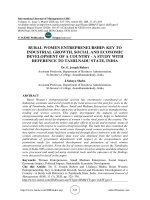Economic growth and economic development 90
Bạn đang xem bản rút gọn của tài liệu. Xem và tải ngay bản đầy đủ của tài liệu tại đây (138.27 KB, 1 trang )
Introduction to Modern Economic Growth
of adjustment to steady state. Similarly, a smaller δ means less replacement of depreciated capital and a smaller n means slower population growth, both of those
slowing down the adjustment of capital per worker and thus the rate of transitional
dynamics.
Example 2.3. (The Constant Elasticity of Substitution Production Function) The previous example introduced the Cobb-Douglas production function,
which featured an elasticity of substitution equal to 1. The Cobb-Douglas production function is a special case of the constant elasticity of substitution (CES)
production function, which imposes a constant elasticity, σ, not necessarily equal
to 1. To write this function, consider a vector-valued index of technology A (t) =
(AH (t) , AK (t) , AL (t)). Then the CES production function can be written as
Y (t) = F [K (t) , L (t) , A (t)]
i σ
h
σ−1
σ−1 σ−1
σ
σ
≡ AH (t) γ (AK (t) K (t))
(2.37)
+ (1 − γ) (AL (t) L (t))
,
where AH (t) > 0, AK (t) > 0 and AL (t) > 0 are three different types of technological change which will be discussed further in Section 2.6; γ ∈ (0, 1) is a
distribution parameter, which determines how important labor and capital services
are in determining the production of the final good and σ ∈ [0, ∞] is the elasticity
of substitution. To verify that σ is indeed the constant elasticity of substitution,
let us use (2.36). In particular, it is easy to verify that the ratio of the marginal
product of capital to the marginal productive labor, FK /FL , is given by
σ−1
1
FK
γAK (t) σ K (t)− σ
=
σ−1
1 ,
FL
(1 − γ) AL (t) σ L (t)− σ
thus, we indeed have that
∙
∂ ln (FK /FL )
σ=−
∂ ln (K/L)
¸−1
.
The CES production function is particularly useful because it is more general and
flexible than the Cobb-Douglas form while still being tractable. As we take the
limit σ → 1, the CES production function (2.37) converges to the Cobb-Douglas
function Y (t) = AH (t) (AK (t))γ (AL (t))1−γ (K (t))γ (L (t))1−γ . As σ → ∞, the
76









